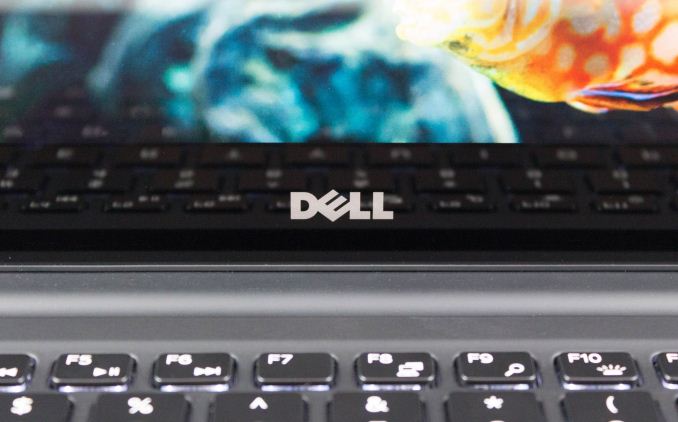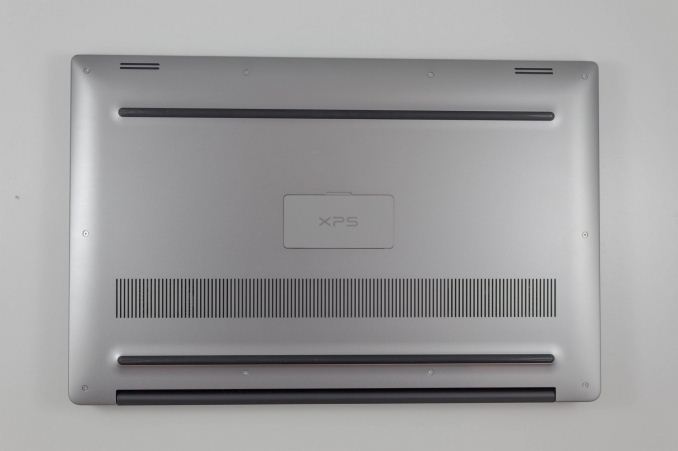The Dell XPS 15 9560 Review: Infinity Edge Part Two
by Brett Howse on July 31, 2017 8:00 AM ESTFinal Words
The XPS 15 9560 is not an all-new machine. That change came with the previous 9550 model, when Dell moved to the new Infinity Edge design. As with the XPS 13, the design is a clear winner, and Dell offers one of the best looking laptops in this category. All of the changes with the 9560 model were all inside, and the changes are mostly result in a better device.
Dell continues to place the webcam below the display on their Infinity Edge laptops, which makes it a less than flattering look when leveraging the webcam, and perhaps for those same reasons, they’ve chosen to go with a fingerprint reader on the keyboard deck as a method to provide Windows Hello biometric login. The fingerprint reader is fast, and accurate, and the only real issue discovered is that it can be difficult to locate in a dim environment, since it blends in almost perfectly with the keyboard deck. A small LED light around the fingerprint reader would help, but this is a small issue.
The aluminum clamshell still looks great, several years after it debuted with the XPS 13, and the soft-touch keyboard deck does show fingerprints, but feels nice on the hands. The added heft of the 15.6-inch over the XPS 13 is noticeable, and the XPS 15 doesn’t feel quite as compact as its smaller brother, even though it’s a 15.6-inch laptop in about the same form factor as most 14-inch models.
Dell has to be commended for keeping the advantages of the XPS 15 intact when making the system smaller. Rather than switching to Ultrabook class parts, like some of their competition, they’ve kept the performance capabilities of a larger notebook. A full quad-core 45-Watt CPU, coupled with a NVIDIA GPU to compliment the integrated GPU, offers significantly more performance than smaller laptops.
The new Kaby Lake based Core i7-7700HQ, despite having the same architecture as the outgoing Skylake model, is indeed a performance bump thanks to the improved 14-nm process from Intel. Dell offers up to 32 GB of DDR4 RAM as well, along with up to 1 TB of SSD storage. There’s plenty of capability here for almost any workload you’d need to do on the go.
The star of the show is the NVIDIA GTX 1050, which offers up to 50% more performance than the outgoing GTX 960M. Dell has also chosen to go with the 4 GB GPU instead of the 2 GB model we tested last year. Maxwell was already a solid performer, but the gains that NVIDIA made with Pascal may not be seen again for a while, thanks to the gains moving to a much newer, FinFET process.
Dell could do a bit more work on the display, and despite the gamut bug we are seeing with this review unit, they don’t individually calibrate the displays even with the PremierColor branding of their wide-gamut UHD display. The application to control this does offer quite a bit of configuration, but Dell could more easily market this to photographers and other creators that want accurate colors if they spent a bit more time on the display. Once calibrated, it’s great, but most people don’t have the tools to do this, so a factory calibration would be ideal.
The increased battery capacity is also a boon, and Dell claims up to 19 hours with the FHD version of this notebook. Although that is likely best-case, the battery life was definitely better on this new model than the 9550 model we tested last year. Still, if you’re a road warrior, the FHD version is likely the best bet. In fact, the FHD version is likely the best bet for most people, since few would take advantage of the wider gamut of the UHD version regardless.
The wireless is the one step backwards. The XPS 15 we reviewed last year featured a Broadcom 3x3:3 wireless NIC, which offers plenty of performance, assuming you have a router than can handle 3x3. It was the first laptop we tested where it never felt necessary to hook it up to Ethernet for copying large files over. The same thing can’t be said of the new XPS 15 9560, which has dropped Broadcom and moved to Killer. The performance drops significantly, thanks to losing one of the spatial streams completely compared to the Broadcom solution, but the stability was not as solid with the Killer. Dell also ships the ancient Windows 8 style network manager software from Killer, rather than Killer’s newer, nicer suite. It would have been nice to see the Intel 8265 that Dell does offer, if only because we've not had a chance to put that NIC through its paces.
Still, that one issue isn’t enough of a reason to not recommend the XPS 15. It continues to be one of the best 15.6-inch laptops on the market today. Dell has kept the performance intact as they shrunk the chassis, unlike many of the other 15.6-inch models from the competition. The aluminum and carbon fibre look is stunning, and other than the less than ideal location of the webcam, Dell’s design wins far more than it loses. If you’re looking for a larger notebook than an Ultrabook, you’d be doing a disservice to yourself to not at least check out the XPS 15.













82 Comments
View All Comments
aznchum - Tuesday, August 1, 2017 - link
I was in this same pickle for the XPS 15 9550 when it first came out in Nov 2015. Issues with lag on waking from sleep and screen flickering. Had to disable the HD 630 graphics to remove the lag waking from sleep and the screen flickering, but that totally kills your battery running the GTX 960M all the time. This may have been fixed with drivers given Skylake was brand-spanking-new at the time. I ponied up the extra money and got the Mid 2015 15" rMBP. Never looked back and never had an issue. If you MUST have windows, use Parallels.nagi603 - Monday, July 31, 2017 - link
A colleague of mine had a faulty keyboard. The right ctrl button got stuck. Factory new, etc... Looks like QC is not the best at Dell.Garrett S. - Monday, July 31, 2017 - link
Laxaa,Check my amazon verified purchase reviews of the Dell XPS 15 9560. I've had 3 different laptops. All 3 have the infamous screen flashing/screen strobing, which occurs randomly, sporadically, at different time frames.
2 laptops were brand new from dell, factory sealed, from Amazon with 4k screen options, and both of the screens were like bloody strobe lights at a dance club. Also had half (left side only) audio coming out of headphone jack on 3 different headphones. I've had bad screens on all 3, defective headphone jacks, and once, on a brand new one, the fn key was bent in the air (again, check the photos).
So I tried a manufacturer refurbished directly from dell, and walla! Same good ole dancing strobe light (but didn't occur as often as the brand new ones did... it took about 2 hours of usage before screen started rapidly flashing like a strobe, which actually induces seizures).
I left reviews on Amazon (video/photo evidence), and mine are verified purchases (which means my reviews are not fake and/or fraudulent).
I'm going to purchase brand new laptop number 4 tomorrow, and most likely later on, number 5, 6, etc...
Dell: Don't worry guys. I'll cycle through hundreds and hundreds of your laptops until I find a working laptop!! I'll help the shipping company with weekly deliveries until you get your act together. For now, I'm writing this on my 2013 Macbook Pro retina, arguably, the world's greatest laptop ever created.
Laxaa - Tuesday, August 1, 2017 - link
I guess ease of mind is what's going to justify spending extra on the MacBook Pro, because that doesn't sound good at all. And I've read similar things on Reddit as well.mr_tawan - Monday, July 31, 2017 - link
It would be great if they include the numeric pad on the keyboard.DanNeely - Monday, July 31, 2017 - link
They can't. Not enough room without using undersize keys for the entire keyboard. Slim bezels mean its about an inch narrower than a traditional fat bezel 15.6" laptop, roughly the size of a 14" fat bezel model which is also too narrow to fit a numpad.If you want slim bezels and a numpad, you'll need to hope someone makes a slim bezel 17" model. Being the size of a 15" fat bezel laptop, it'll again be wide enough to fit one.
tipoo - Monday, July 31, 2017 - link
I actually feel the opposite, I'd rather a centered keyboard and trackpad than a numpad. If you do data entry there's always external numpads. Most people don't use them that much and the keys are redundant.twtech - Tuesday, August 1, 2017 - link
I'm really glad it doesn't have a numeric keypad. That's the #1 thing I look to avoid when comparing models, and it pretty much rules out everything over 15".I'm actually pretty proficient at using a number pad, but when I have it I use it so rarely, it's not worth having the main part of the keyboard be off-center. I actually don't even use a number pad on my desktop computers either - it's a waste of space.
mr_tawan - Wednesday, August 2, 2017 - link
I agreed that it's not for everyone. For English-only usage it's fine not having a numeric pad. In my case, I also use Thai as well. Thai layout covers the whole main keyboard with no room for numbers (as it contains its own set of numeric characters as well). The only other way to input (Arabic) number is to switch the layout back to English, which is a little bit cumbersome.Anyway thanks for all input (@tipoo, @twtech, andDanNeely). Appreciated.
Glock24 - Wednesday, August 2, 2017 - link
Totally agree. I can't stand the keyboard being off center because of the num pad, and even worse, some laptops have Frankenstein key shapes, sizes and layouts to make the num pad fit.